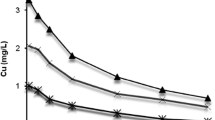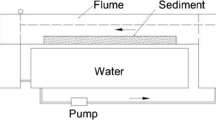Abstract
Factorial design plan was experimented in Perna perna in order to find out the contribution of day exposure, Cd and Cu concentrations in water, and their interactions on metallothioneins (MT), Cd, and Cu (the dependent measured variables) in the gills. The picture obtained is more adequate than by studying the factor effect separately. Compared with the control group, the MT concentration after 22 days exposure period in the mixture of 100 μg/mL Cu and Cd is increased almost two times, showing that P. perna might be used as a biomonitor. Cd showed stronger effect than Cu on MT inducing.
Similar content being viewed by others
References
Amiard, J. C., Amiard-Triquet, C., Barka, S., Pellerin, J., & Rainbow, P. S. (2006). Metallothioneins in aquatic invertebrates: their role in metal detoxification and their use as biomarkers. Aquatic Toxicology, 76, 160–202.
Baraj, B., Niencheski, L. F., & Celso, C. (2003). Trace metal content trend of mussel P. perna from the Atlantic Coast of Southern Brazil. Water, Air and Soil Pollution, 145, 205–214.
Baraj, B., Niencheski, L. F., Trapaga, R., Franca, R., Cocoli, V., & Robinson, D. (1999). Study of interference in the flame atomic absorption spectrometric determination of lithium by using factorial design, Fresenius. Journal of Analytical Chemistry, 364, 678–681.
Baudrimont, M., Metivaud, J., Maury-Brachet, R., Ribeyre, F., & Boudou, A. (1997). Bioaccumulation and metallothionein response in the Asiatic clam (Corbicula fluminea) after experimental exposure to Cd and inorganic mercury. Environmental Toxicology and Chemitry, 16, 2096–2105.
Bebianno, M. J., & Langston, W. J. (1991). Metallothionein induction in Mytilus edulis exposed to Cd. Marine Biology, 108, 91–96.
Bebianno, M. J., & Langston, W. J. (1992). Cd induction of metallothionein synthesis in Mytilus galloprovincialis. Comparative Biochemistry and Physiology C, 103(1), 79–85.
Bebianno, M. J., Nott, J. A., & Langston, W. J. (1993). Cadmimum metabolism in the clam Ruditapes decussata: The role of metallothioneins. Aquatic Toxicology, 27, 315–334.
Brouwer, M., Syring, R. A., & Hoexum-Brouwer, T. (2002). Role of a copper-specific metallothionein of the blue crab, Callinectes sapidus, in copper metabolism associated with degradation and synthesis of hemocyanin. Jounal of Inorganic Biochemistry, 88, 228–239.
Cosson, R. P. (2000). Bivalve metallothionein as a biomarker of aquatic ecosystem pollution by trace metals: Limits and perspectives. Cellular and Molecular Biology, 46, 311–330.
Funes, V., Alhama, J., Navas, J. I., Lopez-Barea, J., & Peinado, J. (2006). Ecotoxicological effects of metal pollution in two mollusk species from the Spanish South Atlantic littoral. Environmental Pollution, 139, 214–223.
Geffard, A., Amiard, J. C., & Amiard-Triquet, C. (2002). Use of metallothionein in gills from oysters (Crassostrea gigas) as a biomarker: Seasonal and intersite fluctuations. Biomarkers, 7(2), 123–137.
Geret, F., Geffard, A., Amiard, J. C., Cosson, R. P., Mouneyrac, C., & Amiard-Triquet, C. (2000). Field and laboratory assessment of metallothionein as a biomarker of metal exposure in oysters. In Proceedings of the third SETAC, world congress, global environmental issues in the 21st century: Problems, causes and solutions, Brighton, UK.
Ivankovic, D., Pavicic, J., Erk, M., Filipvic-Marijic, V., & Rasor, B. (2005). Evaluation of the Mytilus galloprovincialis Lam. Digestive gland metallothionein as biomarker in a long-term field study: Seasonal and spatial variability. Marine Pollution Bulletin, 50, 1303–1313.
Kraak, M. H. S., Lavy, D., Peeters, W. H. M., & Davids, C. (1992). Chronic ecotoxicity of copper and Cd to the zebra mussel Dreissena polymorpha. Archives of Environmental Contamination Toxicology, 23, 363–369.
Lares, M. L., & Orians, K. J. (2001). Differences in Cd elimination from Mytilus californianus and Mytilus trossulus soft tissues. Environmental Pollution, 112, 201–207.
Lecoeur, S., Videmann, B., & Berny, P. (2004). Evaluation of metallothionein as a biomarker of single and combined Cd/Cu exposure in Dreissena polymorpha. Environmental Research, 94, 184–191.
Massart, D. L., Vandeginste, B. G. M., Deming, S. N., Michotte, Y., & Kaufman, L. (1988). Chemometrics. Netherland: Elsevier.
Noël-Lambot, F., Gerday, C. H., & Disteche, A. (1978). Distribution of Cd, Zn and cu in liver and gills of the eel Anguilla anguilla with special reference to metallothioneins. Comparative Biochemistry and Physiology C, 61, 177–187.
Philips, D. J. H. (1980). Cd in the environment. In J. O. Nriagu (Ed.), Part I: Ecological cycling (pp. 450–483). New York: Wiley-Interscience.
Puente, X., Villares, R., Carral, E., & Carballeira, A. (1996). Nacreous shell of Mytilus galloprovicialis as biomonitor of heavy metal pollution in Galizia (NW Spain). The Science of the Total Environmental, 183, 205–211.
Roesijadi, G. (1996). Metallothionein and its role in toxic metal regulation. Comparative Biochemistry and Physiology C, 113, 117–123.
Roesijadi, G., & Klerks, P. L. (1989). Kinetic analysis of Cd binding to metallothionein and other intracellular ligands in oyster gills. Journal of Experimental Zoology, 251, 1–12.
Viarengo, A., Burlando, B., Dondero, F., Marro, A., & Fabbri, R. (1999). Metallothionein as a tool in biomonitoring programmes. Biomarkers, 4, 455–466.
Viarengo, A., Burlando, N., Ceratto, N., & Panfoli, I. (2000). Antioxidant role of metallothioneins: A comparative overview. Cellular and Molecular Biology, 46, 407–417.
Viarengo, A., Pertica, M., Mancinelli, G., Palmero, S., Zanicchi, G., Bouquegneau, J. M., et al. (1984). Biochemical characterization of copper-thioneins isolated from the tissues of mussels exposed to the metal. Molecular Physiology, 5, 41–52.
Viarengo, A., Pertica, M., Mancinelli, G., Zanicchi, G., & Orunesu, M. (1980). Rapid induction of copper-binding proteins in the gills of metal exposed mussels. Comparative Biochemistry and Physiololgy C, 67, 215–218.
Wu, R. S. S., Lau, T. C., Fung, W. K. M., Ko, P. H., & Leung, K. M. Y. (2007). An ‘artificial mussel’ for monitoring heavy metals in marine environments. Environmental Pollution, 145, 104–110.
Yang, M. S., & Thompson, J. A. J. (1996). Binding of endogenous copper and zinc to Cd-induced metal-binding proteins in various tissues of Perna viridis. Archives of Environmental Contamination and Toxicology, 30, 267–273.
Author information
Authors and Affiliations
Corresponding author
Rights and permissions
About this article
Cite this article
Baraj, B., Niencheski, F., Fillmann, G. et al. Assessing the effects of Cu, Cd, and exposure period on metallothionein production in gills of the Brazilian brown mussel Perna perna by using factorial design. Environ Monit Assess 179, 155–162 (2011). https://doi.org/10.1007/s10661-010-1725-8
Received:
Accepted:
Published:
Issue Date:
DOI: https://doi.org/10.1007/s10661-010-1725-8




